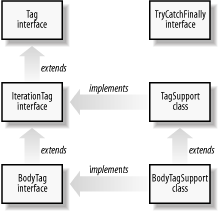20.1 Tag Extension Basics
A custom action -- actually a tag handler
class for a custom action -- is basically a bean, with
property setter methods corresponding to the custom action
element's attributes. In addition, the tag handler class must
implement one of three Java interfaces defined by the JSP
specification.
All the interfaces and classes you need to
implement a tag handler are defined in the
javax.servlet.jsp.tagext package. The three primary
interfaces are named Tag,
IterationTag, and BodyTag. The
Tag interface defines the
methods you need to implement for any action. The
IterationTag interface
extends the Tag interface and adds methods needed for
iteration over the action element's body. The
BodyTag interface extends the
IterationTag interface and adds methods that provide
access the content of the action element's body.
There's also a fourth interface named
TryCatchFinally; it's a
so-called mix-in interface,
meaning it can be implemented in addition to any of the three
main interfaces. It defines methods that let the tag handler
deal with potential exceptions, for instance, those thrown by
JSP elements nested in the action element's body.
To make it easier to develop a tag handler,
two support classes are defined by the API:
TagSupport and BodyTagSupport, as shown in
Figure
20-1. The TagSupport
class provides default implementations for the methods in both
the Tag and the IterationTag interfaces, and
BodyTagSupport adds defaults
for the BodyTag interface methods.

The reason the specification defines both
interfaces and support classes that implement those interfaces
is to cover all the bases. If you already have a bean class
with functionality you want to access as a custom action, you
can specify that it implements the appropriate interface and
add the few methods defined by that interface. In practice
though, I recommend that you implement your tag handlers as
extensions to the support classes. This way you get most of
the methods implemented for free, and you can still reuse the
existing classes by calling them from the tag handler.
A tag
library
is a collection of custom actions. For instance, all custom
actions used in this book are packaged as one tag library.
Besides the tag-handler class files, a tag library must
contain a Tag Library
Descriptor (TLD) file. This is
an XML file that maps all custom action names to the
corresponding tag handler classes and describes all attributes
supported by each custom action. The class files and the TLD
can be packaged in a JAR file to make installation easier. We
look at the TLD syntax and packaging details at the end of
this chapter.
Before getting into all the intricate
details, let's take a brief look at what it takes to develop,
deploy, and use a custom action. First, you implement a tag handler class, like the following
class: package com.mycompany;
import java.io.*;
import javax.servlet.jsp.*;
import javax.servlet.jsp.tagext.*;
public class HelloTag extends TagSupport {
private String name = "World";
public void setName(String name) {
this.name = name;
}
public int doEndTag( ) {
try {
pageContext.getOut( ).println("Hello " + name);
}
catch (IOException e) {} // Ignore it
return EVAL_PAGE;
}
}
The tag handler class contains a setter
method for an attribute called name. The
doEndTag( ) method (defined by the Tag
interface) simply writes "Hello" plus the name
attribute value to the response.
To compile the class,
you must include the JSP API classes in the CLASSPATH
environment variable. The classes are distributed with all
compliant containers. For Tomcat 4, you find them in the
servlet.jar file located in the common/lib
directory under the Tomcat installation directory. When you
have compiled the tag handler, place the class file in the
WEB-INF/classes directory structure for the application
so the container can find it.
Next, you create the TLD file. The following
is a minimal TLD file for a library with just one custom
action element: <?xml version="1.0" encoding="ISO-8859-1" ?>
<!DOCTYPE taglib
PUBLIC "-//Sun Microsystems, Inc.//DTD JSP Tag Library 1.2//EN"
"http://java.sun.com/dtd/web-jsptaglibrary_1_2.dtd">
<taglib>
<tlib-version>1.0</tlib-version>
<jsp-version>1.2</jsp-version>
<short-name>test</short-name>
<uri>com.mycompany.mylib</uri>
<tag>
<name>hello</name>
<tag-class>com.mycompany.HelloTag</tag-class>
<body-content>empty</body-content>
<attribute>
<name>name</name>
</attribute>
</tag>
</taglib>
The TLD maps the custom action name
hello to the tag handler class
com.mycompany.HelloTag and defines the name
attribute. Place the TLD file in the application's
WEB-INF/tlds directory, for instance with the filename
mylib.tld.
Now you're ready to use the custom action in
a JSP page, like this: <%@ taglib prefix="test" uri="com.mycompany.mylib" %>
<html>
<body bgcolor="white">
<test:hello name="Hans" />
</body>
</html>
When the page is requested, the JSP container
uses the taglib directive to find the TLD, and the
TLD to figure out which class to execute for the custom
action. It then calls all the appropriate methods, resulting
in the text "Hello Hans" being added to the response. That's
all there's to it for the most simple case. In the remainder
of this chapter we'll go through all of this in greater
detail.
| 